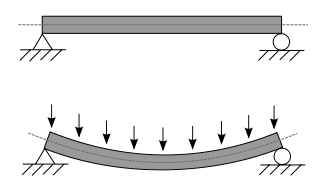Bob
Have a question related to this hub?
Alice
Got something to say related to this hub?
Share it here.
This article relies largely or entirely on a single source. (March 2023) |
In engineering, span is the distance between two adjacent structural supports (e.g., two piers) of a structural member (e.g., a beam). Span is measured in the horizontal direction either between the faces of the supports (clear span) or between the centers of the bearing surfaces (effective span):[1]

A span can be closed by a solid beam or by a rope. The first kind is used for bridges, the second one for power lines, overhead telecommunication lines, some type of antennas or for aerial tramways.[citation needed]

Span is a significant factor in finding the strength and size of a beam as it determines the maximum bending moment and deflection. The maximum bending moment and deflection in the pictured beam is found using:[2]
where
The maximum bending moment and deflection occur midway between the two supports. From this it follows that if the span is doubled, the maximum moment (and with it the stress) will quadruple, and deflection will increase by a factor of sixteen.